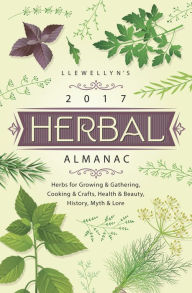Llewellyn is known for turning out interesting and useful almanacs every year, and the 2017 edition of their Herbal Almanac is no exception. This year’s almanac includes 31 articles on a wide variety of herb-related topics. The subject matter runs further afield than just “straight” herbalism to include topics such as gardening, crafts, and recipes. In fact, much of the book includes things you can do, not just read about, and that’s what I like best about it.
The book is divided into sections that organize the articles by general content. It begins with Growing and Gathering Herbs, then moves on to Culinary Herbs and Herbs for Health and Beauty. There’s a section on Herb Crafts as well as one on Herb History, Myth, and Lore. At the end there’s also a collection of tables listing the Moon signs and phases for gardening purposes. I’ll highlight some of my favorite pieces in this review, but really, they’re all worth your time.
Let’s begin with the section titled Growing and Gathering Herbs. As a longtime Brother Cadfael fan, I really enjoyed Natalie Zaman’s article “Unraveling the Tapestry of the Medieval Garden.” She includes directions for creating your own medieval-style herb garden as well as how-to’s for herbed food and herbal remedies. Of course, she does warn that many of the “old-fashioned remedies” that she quotes from centuries-old sources are for “teaching purposes only.” Still, they’re fun to read about. I’ll take the advice I found in Jill Henderson’s article “The Herbal Insectary” to help increase the population of pollinators and natural insectivores in my garden. James Kambos’ article “For the Bees” also offers some great pointers to help support these vital and fascinating insects.
In the Culinary Herbs section, I found beverage recipes (both alcoholic and non-alcoholic) written up by Susan Pesznecker and a recipe for Cranberry Ketchup by Doreen Shababy. I’ve added these to my “I need to make this” kitchen list. I also enjoyed J.D. Hortwort’s piece “Pocket Poor, Flavor Rich: Substitutes for Herbs and Spices.” What a great idea to find less-expensive herbs that will work just as well for flavor and scent in your food, drink, and other concoctions.
The section on Herbs for Health and Beauty includes an article by Lupa titled “Plant Therapy,” about how gardening, nature time, and even indoor houseplants are all helpful for health and well-being. Of course, this isn’t news to most of us, but it’s gratifying to see that science is finally catching up with what those infamous old wives have been saying for so long. In the same section, Diana Rajchel’s article “Rhodiola and the Adaptogens: Your Stress Relief” highlights an issue that’s less often addressed in writing about herbs: how to handle the long-term effects of the chronic stress caused by modern life. In our instant gratification culture that wants to pop a pill for every symptom and see results in mere minutes, it takes a shift in mindset to understand how to use herbal tonics to support health over the long run.
The Herb Crafts section includes a lot of fun projects that also have a spiritual aspect to them, from tiny raffia-and-cinnamon-stick brooms to Japanese Shinto paper streamers to fruit and spice pomanders. As a weaver, spinner, and dyer myself, I really enjoyed Monica Crosson’s article “A Garden to Dye For.” I’ve used natural dyes for years but have rarely grown the plants for dyestuffs myself. The idea of dedicating an entire garden to natural dyes is just enchanting. After all, herbs and flowers that provide natural dyes are a special kind of magic, don’t you think?
The section on Herb History, Myth, and Lore contains quite a wide range of articles, all of them fascinating. I’m a longtime Beatrix Potter fan and have even visited Hilltop, Ms. Potter’s museum-ified home in the Lake District of Britain. Ms. Potter was a talented and dedicated conservationist and student of the natural sciences, an aspect of her life that’s often overlooked in favor of her cute children’s books. But Thea Fiore-Bloom’s article about the natural history in Ms. Potters’ stories brings it all home: the incredibly accurate depictions of herbs, flowers, insects, and even mushrooms that give those books their magic because they’re so real, you can almost smell and touch them.
The final section of the almanac contains not articles but tables full of information. They include the Moon phases, the meanings of the Moon in different astrological signs, and tables of the daily Moon sign by month, including whether each day is good for planting or weeding.
All in all, this is a fun and fascinating look at many aspects of the world of herbs. I encourage not just to read the book, but to take action and try out the projects and recipes in the different sections. If you do them all, you’ll have a very herbal year!
~review by Laura Perry
Author: Llewellyn Publications
Llewellyn, 2016
pp. 311, $11.99
Llewellyn's 2017 Herbal Almanac

©
2010 - 2025
Facing North
